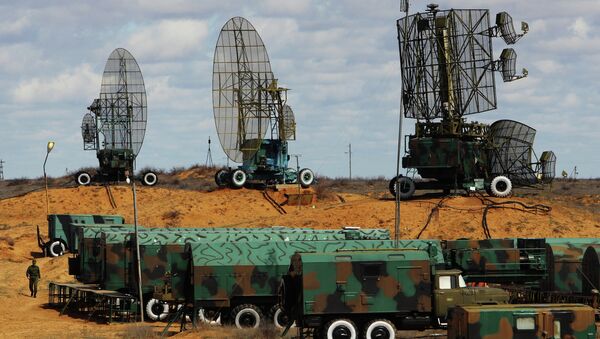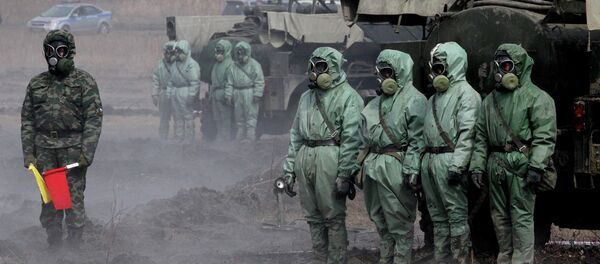MOSCOW, December 15 (Sputnik) — On December 15, the Russian Armed Forces celebrate the founding of the Air Force's Radio-Technical Troops.
The Radio-Technical Troops (RTT) is a subdivision of the Russian Air Force. Their objective is to carry out the radar reconnaissance of enemies in the air and report radar information to the command-and-control elements of the Air Force and parts of the Russian Armed Forces.
The RTT is a relatively new. In their current form, they were created in January 1952, but they have much deeper historical roots. The need to alert the population and troops of approaching enemy aircraft became imperative during World War I, prompting the creation of "horizon observation posts" to help defend the city of Petrograd and the Tsarskoe Selo, suburb of St. Petersburg, from air attacks. Later, these posts merged into the Aerial Surveillance, Warning, and Communication Service (ASWC).
In the postwar years, it became increasingly important to have information on enemy air forces and the timing of a possible attack, and to prevent and control the enemy's air reconnaissance.
On December 15, 1951, the USSR Council of Ministers issued a resolution, which established the Radio-Technical Troops as a combat arm of the National Air Defense (AD) and the radar service of the AD fighter aviation. They were based on the ASWC. They were officially called the Radio-Technical Troops of the Aerial Surveillance, Warning, and Communication Service of the National Air Defense. In 1955, they were renamed the Radio-Technical Troops of the National Air Defense, and in 1980, the Radio-Technical Troops of the Air Defense.
From the late 1950s to the mid-1960s the Radio-Technical Troops underwent rapid development. The combat arm was extensively supplied with the most advanced radar equipment of the day, and new forces were deployed. From the mid-1960s to the late 1970s, the combat arm continued adopting new equipment, most importantly automated control systems.
In the 1980s, the combat arm was supplied with new weaponry and military equipment, including significantly more powerful radar systems and radar stations, based on state-of-the-art technology developed by Soviet programmers and radio engineers. An extensive rearmament program facilitated the creation of automated radar systems within combined units and large strategic formations of the Air Defense Forces.
Radar coverage in the Soviet Union made it possible to continuously track aircraft movements across the country's airspace.
After the collapse of the Soviet Union the Air Defense Forces were significantly weakened. The disbandment of a large number of radio-technical units disrupted the continuity of radar coverage over Russia and made the air defense system less capable.
The Federal Airspace Reconnaissance and Control System (FARCS) was created on January 14, 1994, by order of the Russian president. The new structure was designed to integrate radar systems and the Air Defense Forces, the Department of Air Transport, the Air Force, and the Navy by means of an automated system. The FARCS management was assigned to the Commander of Air Defense Forces, who exercised his power through the commanders of the various air defense areas.
In 1998, the Air Defense Forces and the Air Force merged into a single service. Units with similar duties were combined, which resulted in the creation of a unified system of radar reconnaissance and radar support based on the Radio-Technical Troops.
The Air Force's RTT have an extensive record of supporting Russian spacecraft landings, including the landing of the first man in space, Yury Gagarin, and the Soviet space shuttle Buran.
RTT officers have worked abroad in China, North Korea, Vietnam, Egypt, Syria, Angola, Cuba, Afghanistan, and a number of other countries.
The RTT consist of radio-technical regiments, which are part of the Air Force, the Space Defense Brigade, and other units under the control of the Air Force High Command.
In peacetime, all deployed RTT units and command posts are on alert duty and protect the state border in airspace.
In 2013, the RTT tracked over 360,000 flights over Russian territory.
The RTT are a high-tech combat arm, equipped with complex and costly modern weapons and military equipment. To operate the high-tech equipment, the service personnel are required to have thorough education and training.
Each year, over 1,000 personnel, including officers and lower-ranking specialist personnel, undergo training and take professional development courses at RTT educational centers.
The main requirement for the radio-electronic equipment supplied to the Radio-Technical Troops is its ability to increase RTT units' maneuverability and their ability to provide information on the current military situation in any new positioning area in the shortest possible time.
The RTT are supplied with advanced radio-electronic equipment, including radar systems and radars such as Nebo, Protivnik, Gamma, Sopka, Kasta, Podlyot, and automated systems like Fundament and Krym.
In 2014, RTT units will receive ten Nebo-ME advanced radar systems capable of detecting any type of aircraft at ranges of over 1,000 kilometers.
By 2015, the share of modern weapons in the RTT is expected to reach at least 30 percent, approaching 70 percent by 2020.


